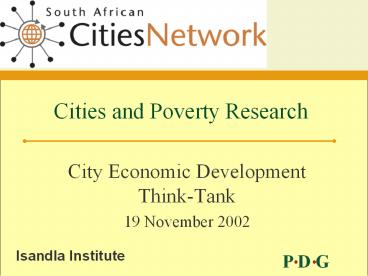Cities and Poverty Research - PowerPoint PPT Presentation
Title:
Cities and Poverty Research
Description:
Cities and Poverty Research City Economic Development Think-Tank 19 November 2002 ... Key lines of exclusion and marginality in South Africa include racism, ... – PowerPoint PPT presentation
Number of Views:157
Avg rating:3.0/5.0
Title: Cities and Poverty Research
1
Cities and Poverty Research
- City Economic Development Think-Tank
- 19 November 2002
2
Project Structure
3
Recognising Urban Poverty
- Urban Growth
- SA reflects global and regional trends in urban
population growth - The big picture is of consistent growth
- Within this there are different patterns in the
rate, location and population that are growing
4
Urban growth - race
5
Urban growth - gender
6
Urban growth - location
7
Urbanisation of poverty
- Three main reasons for the urbanisation of
poverty - The natural growth of the poor population within
cities - Growing urban inequality
- Poor people moving to cities
8
Who are the urban poor in SA
- If there is a typical face of poverty in South
Africa then this picture is no longer only a
rural women engaged in subsistence agricultural
production. It is an HIV child living in an
environmentally degraded informal settlement in a
rapidly growing city - without services who is
subjected to organised and household violence and
is vulnerable to global economic and political
trends. - FS Mufamadi, Minister For Provincial and Local
Government, SACN Launch 7 October 2002
9
Who are the urban poor in SA?
10
Who are the urban poor in SA?
11
Poverty definition
- Poverty is more than a lack of income. Poverty
exists when an individual or a households access
to income, jobs and/or infrastructure is
inadequate or sufficiently unequal to prohibit
full access to opportunities in society. The
condition of poverty is caused by a combination
of social, economic, spatial, environmental and
political factors.
12
Poverty definition
Energy
Health
Crime
Unemployment
Literacy
Water
Income
Disability
Poverty
Gender
Housing
Environmental Health
Transport
Waste
CDI
Gini
13
Recording and monitoring poverty
- Choose the appropriate indicators of urban
poverty - Select the correct scale
- Monitor vulnerable groups
- Identify sectoral weaknesses
- Use up-to-date, reliable data
14
Choose the right indicator
15
Select the right scale
16
Identify vulnerable groups
17
Making complex data useful
- Must be understood by all stakeholders
- Must be flexible - accommodate new data and
refinement - Must interface with other data e.g. budget,
provincial data, community priorities etc. - Must be authoritative - locally and
internationally and internally and externally
18
The City Development Index
19
Customising the CDI for SA
20
Customising the CDI for SA
21
Customising the CDI for SA
22
Customising the CDI for SA
23
Customising the CDI for SA
24
Gaps in the CDI
- Does not capture all dimensions of poverty
- Infrastructure heavy
- Not all locally specific poverty dynamics are
addressed - e.g. segregation - Key aspects of city development are not included
25
Introducing SAPIC
26
SAPIC and budget
27
Introducing SAPIC
28
Introducing SAPIC
29
Introducing SAPIC
30
Introducing SAPIC
31
Introducing SAPIC
32
Calculating quality of life indices
33
Inequality indicators - Gini coefficients (Jhb -
Africans)
34
Gender-related Development Index
35
Poverty lines (eThekweni)
36
Project Structure
37
Responding and intervening
38
Conclusion































